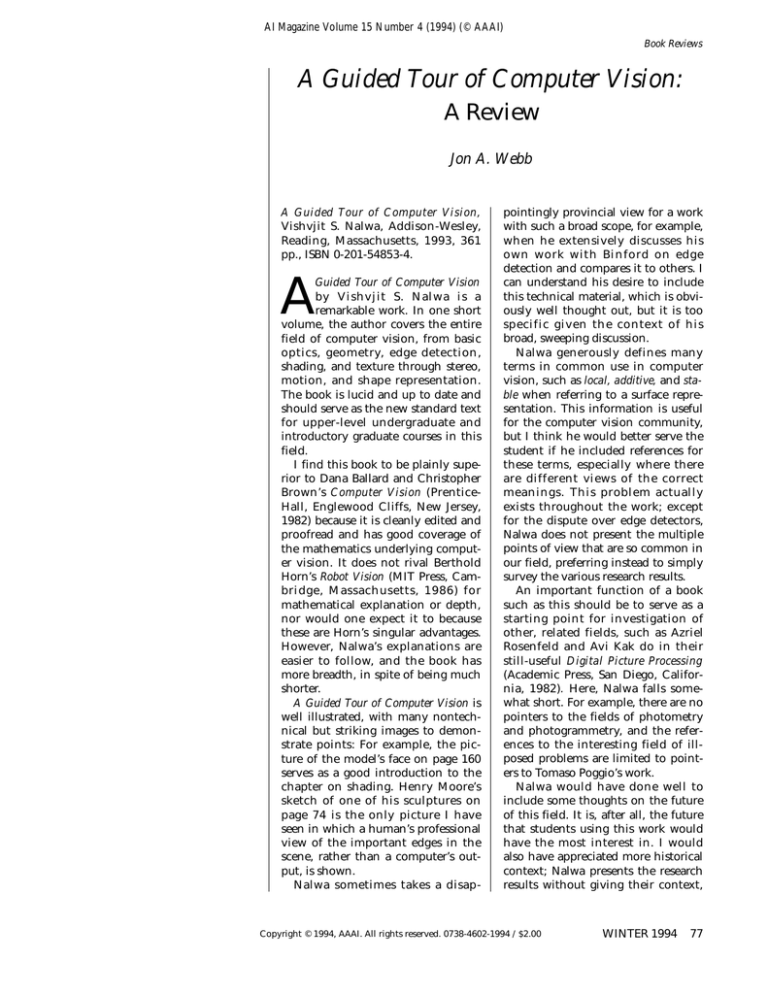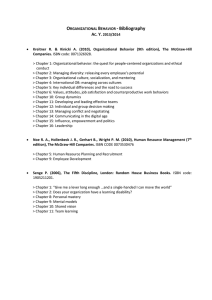
AI Magazine Volume 15 Number 4 (1994) (© AAAI)
Book Reviews
A Guided Tour of Computer Vision:
A Review
Jon A. Webb
A Guided Tour of Computer Vision,
Vishvjit S. Nalwa, Addison-Wesley,
Reading, Massachusetts, 1993, 361
pp., ISBN 0-201-54853-4.
A
Guided Tour of Computer Vision
by Vishvjit S. Nalwa is a
remarkable work. In one short
volume, the author covers the entire
field of computer vision, from basic
optics, geometry, edge detection,
shading, and texture through stereo,
motion, and shape representation.
The book is lucid and up to date and
should serve as the new standard text
for upper-level undergraduate and
introductory graduate courses in this
field.
I find this book to be plainly superior to Dana Ballard and Christopher
Brown’s Computer Vision (PrenticeHall, Englewood Cliffs, New Jersey,
1982) because it is cleanly edited and
proofread and has good coverage of
the mathematics underlying computer vision. It does not rival Berthold
Horn’s Robot Vision (MIT Press, Cambridge, Massachusetts, 1986) for
mathematical explanation or depth,
nor would one expect it to because
these are Horn’s singular advantages.
However, Nalwa’s explanations are
easier to follow, and the book has
more breadth, in spite of being much
shorter.
A Guided Tour of Computer Vision is
well illustrated, with many nontechnical but striking images to demonstrate points: For example, the picture of the model’s face on page 160
serves as a good introduction to the
chapter on shading. Henry Moore’s
sketch of one of his sculptures on
page 74 is the only picture I have
seen in which a human’s professional
view of the important edges in the
scene, rather than a computer’s output, is shown.
Nalwa sometimes takes a disap-
pointingly provincial view for a work
with such a broad scope, for example,
when he extensively discusses his
own work with Binford on edge
detection and compares it to others. I
can understand his desire to include
this technical material, which is obviously well thought out, but it is too
specific given the context of his
broad, sweeping discussion.
Nalwa generously defines many
terms in common use in computer
vision, such as local, additive, and stable when referring to a surface representation. This information is useful
for the computer vision community,
but I think he would better serve the
student if he included references for
these terms, especially where there
are different views of the correct
meanings. This problem actually
exists throughout the work; except
for the dispute over edge detectors,
Nalwa does not present the multiple
points of view that are so common in
our field, preferring instead to simply
survey the various research results.
An important function of a book
such as this should be to serve as a
starting point for investigation of
other, related fields, such as Azriel
Rosenfeld and Avi Kak do in their
still-useful Digital Picture Processing
(Academic Press, San Diego, California, 1982). Here, Nalwa falls somewhat short. For example, there are no
pointers to the fields of photometry
and photogrammetry, and the references to the interesting field of illposed problems are limited to pointers to Tomaso Poggio’s work.
Nalwa would have done well to
include some thoughts on the future
of this field. It is, after all, the future
that students using this work would
have the most interest in. I would
also have appreciated more historical
context; Nalwa presents the research
results without giving their context,
Copyright © 1994, AAAI. All rights reserved. 0738-4602-1994 / $2.00
WINTER 1994
77
Book Reviews
comparing techniques developed
years apart without the background
needed to understand their origin
and motivation.
I
n summary, I find this an extremely useful work. It serves as a broad,
elementary introduction to computer vision, which has been lacking
in recent years. It performs useful
work for the field in defining many
terms in common use. It also serves
as an excellent reference to much
contemporary work. However, it does
not encourage the reader to explore
the field in greater depth, except by
turning to computer vision publications; the many related fields that
have contributed so much to computer vision are slighted. It also does
not convey well the multitudinous
points of view still present in this
rich field.
Jon A. Webb is a senior systems scientist
in the School of Computer Science at
Carnegie Mellon University. Prior to joining the university in 1982, he received his
Ph.D. from The University of Texas at
Austin. Webb’s research interests lie at the
intersection of parallel computing and
computer vision; he has published extensively in these areas.
Proceedings of the Second
Conference on Artificial
Intelligence Planning Systems
Edited by Kristian Hammond
The papers in this work present
current state-of-the-art research in
AI planning systems. Reviewed
papers present research on how to
generate plans to succeed in uncertain environments, improving
robot plans during their execution,
managing dynamic temporal constraint networks, solving time-critical decision making problems,
and more.
360 pp., index. ISBN 0-929280-56-3
$45.00 softcover
To order, call AAAI at (415) 328-3123
78
AI MAGAZINE
Books Received
Attention Authors!
If you would like us to consider your
book for review, have your publishers
send a review copy to AI Magazine,
445 Burgess Drive, Menlo Park, CA
94025. We’ll include it in the next
books received column. Receipt of a
review copy, of course, doesn’t guarantee a review!
($34.95, VHS/NTSC; $44.95, SECAM;
$44.95, PAL).
Kuipers, Benjamin. Qualitative Reasoning: Modeling and Simulation with
Incomplete Knowledge. Cambridge,
Mass.: The MIT Press, 1994. 418 pp.
$45.00. ISBN 0-262-11190-X.
■
Liebowitz, Jay, editor. Moving
Toward Expert Systems Globally in the
Twenty-First Century. Port Washington, N.Y.: Scholium International,
Inc., 1994. 1576 pp. $330.00. ISBN 1882345-00-2.
■
Liebowitz, Jay, editor. Worldwide
Expert Systems Activities and Trends.
Port Washington, N.Y.: Scholium
International, Inc., 1994. $48.00. 172
pp. ISBN 1-882345-02-9.
■
The following books were received by
press time:
Begault, Durand R. 3-D Sound for
Virtual Reality and Multimedia. San
Diego, Calif.: Academic Press, 1994.
293 pp. $49.95. ISBN 0-12-084735-3.
■
Bertol, Daniela. Visualizing with
CAD: An AutoCAD® Exploration of
Geometric and Architectural Forms.
Berlin: Springer-Verlag, 1994. 360 pp.
ISBN 0-387-94275-0.
■
■ Borenstein, Nathaniel S. Programming as if People Mattered. Princeton,
N.J.: Princeton University Press, 1994.
182 pp. $14.95. ISBN 0-691-03763-9.
Fauconnier, Gilles. Mental Spaces:
Aspects of Meaning in Natural Language. New York: Cambridge University Press, 1994. 190 pp. $14.95. ISBN
0-521-44499-3 (cloth). $14.95. ISBN
0-521-44949-9 (paper).
■
Joshnson, J. H.; Sean McKee, and
Alfred Vella. Artificial Intelligence in
Mathematics. Oxford: Clarendon
Press, 1994. 328 pp. $67.50. ISBN 019-853686-0
■
Josephson, John R., and Josephson,
Susan G., editors. Abductive Inference:
Computation, Philosophy, Technology.
New York: Cambridge University
Press, 1994. 306 pp. $49.95. ISBN 0521-43461-0.
■
Kolodner, Janet. Case-Based Reasoning. San Francisco, Calif.: Morgan
Kaufmann Publishers, 1994. 668 pp.
ISBN 1-55860-237-2.
■
Koza, John R. Genetic Programming
II: Automatic Discovery of Reusable Programs and Genetic Programming II
Video: The Next Generation. Cambridge, Mass.: The MIT Press, 1994.
$45.00, cloth. ISBN 0-262-11189-6
■
Manaktala, Gita. Turtles, Termites,
and Traffic Jams: Explorations in Massively Parallel Microworlds. Cambridge,
Mass.: The MIT Press, 1994. 163 pp.
$24.95. ISBN 0-262-18162-2.
■
McNeill, Martin, and Thro, Ellen.
Fuzzy Logic: A Practical Approach. San
Diego, Calif.: Academic Press, 1994.
292 pp. $39.95. ISBN 0-12-485965-8.
■
Pratt, Ian, editor. Artificial Intelligence. Port Washington, N.Y.: Scholium International, Inc., 1994. 280 pp.
$35.00. ISBN 0-333-59755-9.
■
Smith, John. Collective Intelligence
in Computer-Based Collaboration. Hillsdale, N.J.: Lawrence Erlbaum Associates, 1994. 248 pp. $24.50 (paper).
$59.95 (cloth). ISBN 0-8058-1320-9.
■
Terano, Toshiro; Asai, Kiyoji; and
Sugeno, Michio. Applied Fuzzy Systems. San Diego, Calif.: Academic
Press, 1994. 302 pp. $39.95. ISBN 012-685242-1.
■
Zavadskas, Edmundas; Peldschus,
Friedel; and Kaklauskas, Arturas. Multiple Criteria Evaluation of Projects in
Construction. Vilniaus, Latvia: Vilniaus Technikos Universitetas, 1994.
227 pp. ISBN 9986-05-046-4.
■
Zbigniew, Michalewicz. Genetic
Algorithms + Data Structures = Evolution Programs: Second, Extended Edition. Berlin: Springer Verlag, 1994.
340 pp. ISBN 3-540-58090-5.
■
Zweben, Monte, and Fox, Mark S.
Intelligent Scheduling. San Francisco
Calif.: Morgan Kaufmann, 1994. 754
pp. ISBN 1-55860-260-7.
■





